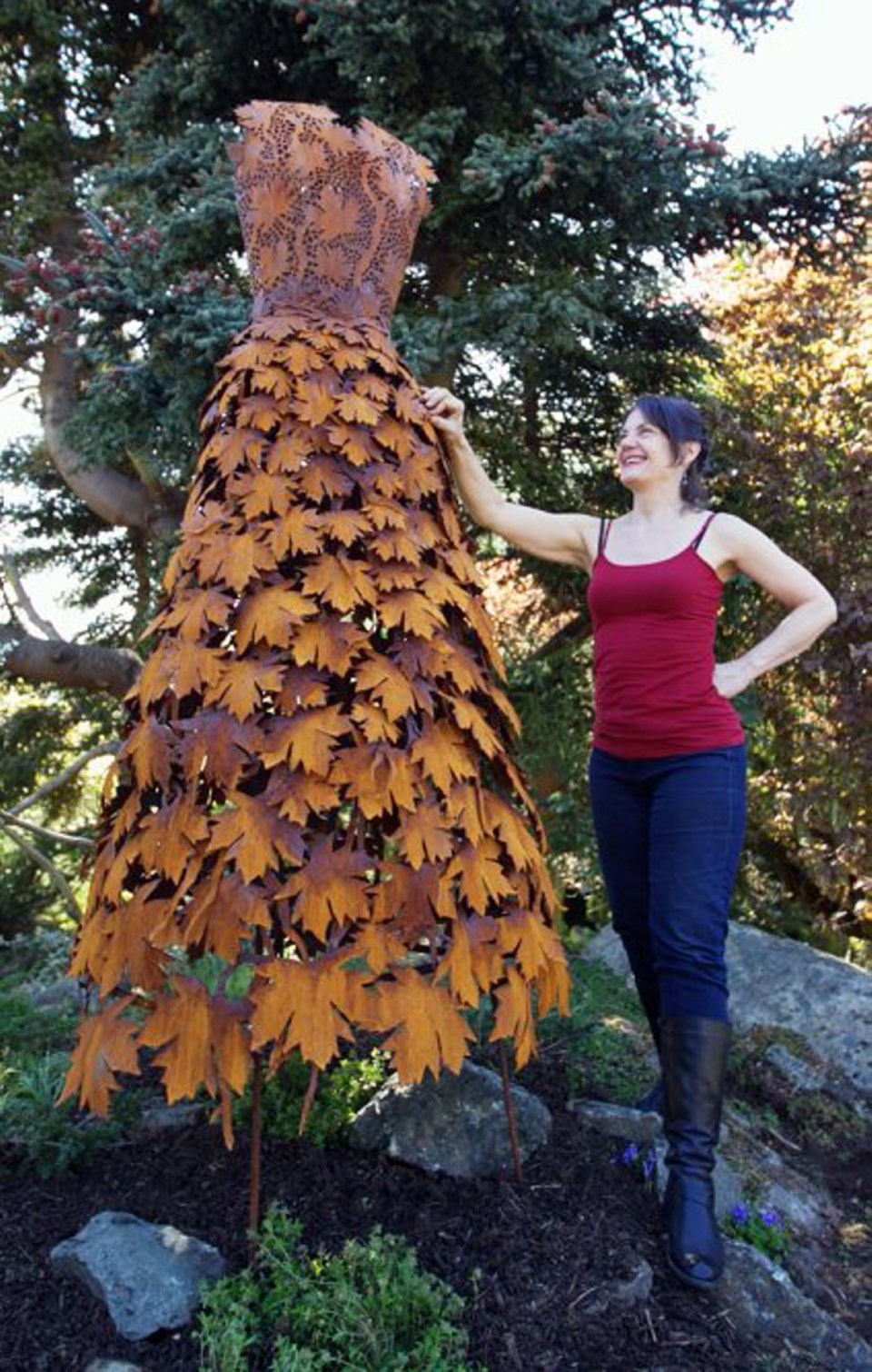Abkhazi Garden is an extraordinary combination of plants and landscape at the border of Oak Bay and Fairfield.
Known as “the garden that love built,” it is the paradise created by Prince Nicholas Abkhazi, a dispossessed nobleman from Georgia, and his bride Peggy, an Englishwoman who had been living under Japanese internment in Shanghai. They came together at the end of the Second World War in Victoria, and on a rocky outcrop created a Chinese-inspired rocks-and-water garden. Its central valley, their own Yangtze River, is grassed and leads to a famous rhododendron grove.
What lured me to Abkhazi Garden this time was a summer-long display of dresses, inspired by the princess’s own wardrobe. These ball gowns are larger than life, and plasma-cut from sheets of steel. The first one I saw, standing high on a rocky promontory, has a tight bodice and a long flowing skirt with maple leaves welded on. They are delicate and rusted to a lovely autumnal hue.
These gowns are the creations of artist Bev Petow from Sooke, who is skilful at dressmaking as well as metal work. Having spied one sculpture, I was intrigued and set out to discover the others.
Up at the “headwaters” of the garden, tucked into a planting, is the Dragon Aunt robe. The front of the garment is a beautiful filigree cut in dragonfly motifs. Only by following the garden path beyond can you find there is a cut and shaped dragon on the robe’s back, relating to Peggy’s arrival from China.
Petow’s willingness to make a suite of beautiful sculptures inspired by this garden, and created especially for it, is remarkable.
Abkhazi Garden is managed by The Land Conservancy and has an on-site tea room and gift shop. If you want to make a good impression on someone, try tea on the terrace at Abkhazi Garden. It’s quite close by. (1964 Fairfield Rd., 250-598-8096)
The Art Gallery of Greater Victoria (1040 Moss St., 250-384-4171, aggv.bc.ca) has a new slate of shows. Emily Carr is there, as she must always be. And before his imminent retirement, Barry Till is bringing out some extraordinary Asian material from the gallery’s vaults. I wrote about the Japanese ink paintings called Nanga a few weeks ago.
Now he has added two more shows. Japanese prints from the Meiji Era — mostly the 1870s and 1880s — show the country wide-eyed and newly opened to the world. It’s reminiscent of the era of Gilbert and Sullivan’s Mikado. With garish colour and loads of topical references, these prints are a sort of early Japanese pop art (until Aug. 28).
In the smallest gallery, Till has fearlessly installed the most blatant pornography ever seen in public in Victoria. Shunga, another sub-genre of Japanese printmaking, holds nothing back: twisting toes, eyes jammed shut, hair splayed out around larger-than-life members. These shunga (spring pictures) were printed as popular sex manuals, or as guides to the red light district. It seems everything the Japanese did, they did artistically (until Oct. 16).
Many shunga in the gallery’s collection have a fascinating provenance. Ichimaru was the most famous geisha of her time, who became the first television geisha in the 1950s. The gallery owns her splendid kimonos, but we now learn that among her materials were these hot books. If you like Japanese art, you might want to sign up for Till’s swan-song tour of Japan this fall.
Leaving old Japan behind, I emerged into the AGGV’s two largest spaces, which this summer are given over to video monitors. A few giant beanbags were flopped on the floor, but there was nobody there. The Centennial Gallery was in semi-darkness, echoing with the blasting soundtrack of a two-screen projection showing an outboard motor. Headsets hung here and there along the walls. Call me old-fashioned, but I never go to an art gallery to watch videos. Trans-Pacific Transmissions will hold centre stage until Sept. 5.
The Federation of Canadian Artists is holding its 75th anniversary exhibition at the Cedar Hill Art Centre (3220 Cedar Hill Rd., 250-475-7121, until July 6). In a column many years ago, I described the Federation of Canadian Artists as “the Holiday Inn of art — expect no surprises.”
The federation specializes in traditional, hang-it-on-the-wall paintings, not the sort of thing that would get you a Canada Council grant, a master of fine art degree or a review in the pages of an esoteric art magazine. But I am confident that you will see good-to-excellent quality paintings, mostly representational, put forward by the most coherent and effective art organization in this province. This is what most people think of as art.
At the federation’s inception in 1941, luminaries such as Lawren Harris were involved, and later, Allan Edwards rescued it from oblivion and brought it to a new level with the Salt Spring Seminars. Many of the artists of the (now-concluded) Painters at Painter’s Lodge event owed allegiance to the FCA. The current FCA senior-signature members are Kristina Boardman, David Goatley, Anne Hudec, Clement Kwan, Catherine Moffat and Marney Ward, and there are 20 associate-signature members.
The federation is made up of eight branches, mostly in B.C. It’s not waiting with its hand out for government support. Members schedule demonstrations and critiques, exhibit in juried shows together, and support one another in the struggle toward a professional or semi-professional career. All over this region, people are buying and living with paintings by FCA members.
The current show will be the best they can put forward, and there’s bound to be something that will impress you. Maybe even a few surprises.



